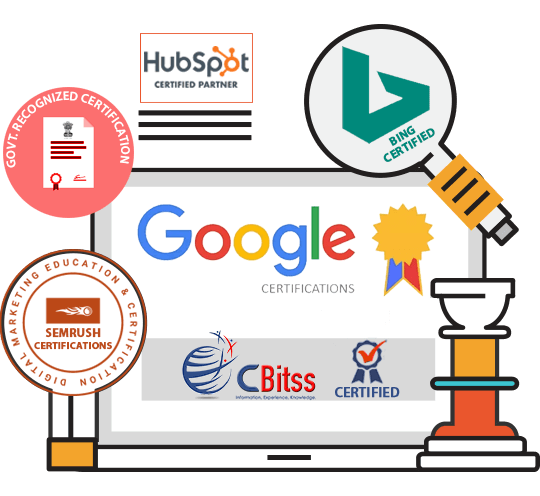What exactly digital marketing?
Digital marketing is a broad term that encompasses all marketing efforts conducted through digital channels or electronic devices. It involves leveraging online platforms, technologies, and data to connect with potential customers and promote products or services. Digital marketing strategies can span various channels, and they are often employed to reach specific target audiences in a more targeted and measurable way compared to traditional marketing methods.
Key components and strategies within digital marketing include:
Search Engine Optimization (SEO)
The process of optimizing a website or online content to improve its visibility in search engine results. The goal is to increase organic (non-paid) traffic from search engines.
Content Marketing
Creating and distributing valuable, relevant, and consistent content to attract and engage a target audience. Content can take various forms, including blog posts, articles, videos, infographics, and more.
Social Media Marketing
Utilizing social media platforms (e.g., Facebook, Instagram, Twitter, LinkedIn) to promote products or services, build brand awareness, and engage with the target audience. This involves both organic content and paid advertising.
Email Marketing
Sending targeted messages to a group of individuals via email. Email marketing is used for various purposes, including promoting products, delivering personalized content, and nurturing customer relationships.
Pay-Per-Click Advertising (PPC)
Running paid advertisements on search engines (like Google Ads) or social media platforms. Advertisers pay a fee each time their ad is clicked, driving traffic to their website.
Affiliate Marketing
Partnering with individuals or other businesses (affiliates) to promote products or services. Affiliates earn a commission for each sale or lead generated through their marketing efforts.
Influencer Marketing
Collaborating with individuals who have a significant following on social media or other online platforms to promote products or services. Influencers can help brands reach a larger and more targeted audience.
Online Public Relations (PR):
Managing a brand’s online presence, reputation, and relationships with the public. This involves activities such as press releases, online reviews, and social media interactions.
Analytics and Data Analysis
Using data and analytics tools to track and measure the performance of digital marketing campaigns. This includes monitoring website traffic, user behavior, conversion rates, and other key metrics.
Marketing Automation
Employing software and tools to automate repetitive marketing tasks, such as email campaigns, social media posting, and lead nurturing.
Digital marketing course in Chandigarh Its offers several advantages, including the ability to target specific audiences, track and analyze campaign performance, and adjust strategies in real-time. It has become an integral part of overall marketing strategies for businesses of all sizes, helping them reach a global audience and adapt to the changing landscape of consumer behavior in the digital age.
What is step digital marketing strategy?
Creating a comprehensive digital marketing strategy involves several key steps to ensure a systematic and effective approach. While the specific details may vary based on the business, industry, and goals, here’s a general step-by-step guide to developing a digital marketing strategy:
Define Your Objectives
Clearly articulate your business goals and what you want to achieve with your digital marketing efforts. Objectives could include increasing brand awareness, driving website traffic, generating leads, or boosting sales.
Identify Your Target Audience
Understand your target audience’s demographics, behaviors, interests, and preferences. This information will guide your marketing messages and help you choose the most effective digital channels.
Conduct a Digital Marketing Audit
Review your current digital presence, including your website, social media profiles, email campaigns, and other online assets. Identify strengths, weaknesses, opportunities, and threats.
Competitor Analysis
Analyze the digital marketing strategies of your competitors. Identify what works well for them and areas where you can differentiate your approach.
Choose Digital Marketing Channels
Select the digital channels that align with your goals and target audience. Common channels include search engines (SEO and PPC), social media, email marketing, content marketing, and online advertising.
Develop a Content Strategy
Create a plan for producing and distributing valuable, relevant, and consistent content. This can include blog posts, videos, infographics, eBooks, and other content formats.
Set a Budget
Determine the financial resources you can allocate to your digital marketing efforts. Allocate budget to different channels and campaigns based on their potential impact and your business priorities.
Implement SEO Strategies
Optimize your website and content for search engines. This includes keyword research, on-page optimization, creating high-quality content, and building backlinks.
Social Media Strategy
Develop a social media plan that aligns with your objectives. Choose the platforms where your audience is most active, create a content calendar, and consider both organic and paid strategies.
Email Marketing Campaigns
Plan and execute email marketing campaigns. Segment your email list, create compelling content, and use automation to nurture leads and engag your audience.
Paid Advertising Campaigns
If applicable, set up and manage paid advertising campaigns on platforms like Google Ads, Facebook Ads, or other relevant ad networks.
Marketing Analytics
Implement tools for tracking and analyzing the performance of your digital marketing campaigns. Monitor key metrics such as website traffic, conversion rates, social media engagement, and return on investment (ROI).
Regularly Review and Adjust
Continuously monitor the performance of your digital marketing efforts and be prepared to adjust your strategy based on data and insights. Stay informed about industry trends and emerging technologies.
User Experience (UX) Optimization
Ensure that your website and digital assets provide a positive user experience. Optimize for mobile devices, improve site speed, and make navigation intuitive.
Conversion Rate Optimization (CRO)
Test and optimize elements of your digital marketing funnel to improve conversion rates. This can include A/B testing landing pages, CTAs, and forms.
Remember that a successful Digital marketing course in Chandigarh sector 34 Its strategy is an ongoing process that requires adaptation to changing market conditions, consumer behavior, and technology. Regularly revisit and update your strategy to stay relevant and effective in the ever-evolving digital landscape.
Read more article:- Techsolutionmaster

